wwhitney
Senior Member
- Location
- Berkeley, CA
- Occupation
- Retired
That, by the way, is a consequence of 215.3 as I indicated earlier. But if you don't buy that, it's also a consequence of UL 489. Per the "Molded Case Circuit Breaker – Marking and Application Guide" available here: https://code-authorities.ul.com/molded-case-circuit-breaker-marking-and-application-guide/If I have a 100A continuous load and a 100A non-continuous load, then the service OCPD needs to be 225A.
"38. 100 Percent Continuous Rated – Unless otherwise marked for continuous use at 100 percent of its current rating, a circuit breaker is intended for use at no more than 80 percent of its rated current where in normal operation the load will continue for three hours or more. . . ."
Cheers, Wayne




